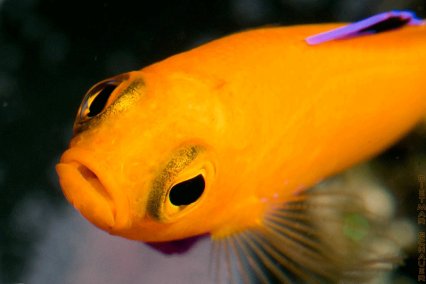A lovely new species of basslet has been described from Cuba.
The Royal Gramma or Fairy Basslet, Gramma loreto, is a species well known to aquarists, and the type species of its genus, which until recently contained just four species.
Then Arie de Jong, the owner of De Jong Marinelife in the Netherlands, noticed that consignments of Royal Grammas from Cuba contained occasional fishes that were almost completely yellow in colour rather than the normal bicolor blue and yellow. They were also smaller and showed some behavioural differences.
Eventually Mr de Jong contacted ichthyologists Benjamin Richter and John. E. Randall to report what appeared to be a new species, and subsequently provided them with preserved specimens. As a result a new paper has recently been published describing the new yellow basslet as Gramma dejongi, thus honouring its discoverer. Not for the first time the aquarium hobby has managed to make a valuable contribution to ichthyology!

The specimens imported to the Netherlands were collected near the town of Trinidad on the south-central coast of Cuba. Information provided to Mr de Jong by the collectors identified the habitat of the species as "walls" at depths of between 20 and 30m (66 and 100 ft), which is deeper than for G. loreto.
The new species measures only about 45mm/1.75in, while the Royal Gramma attains over 80mm (just over 3in), and the coloration is also quite different, though the two species overlap completely in their counts and morphology.
They also appear to be effectively identical genetically. The authors therefore discuss at some length whether or not the new fish might be a morph or a subspecies of G. loreto, concluding that the answer is no.
They point out that near-identical DNA is commonplace in sibling species, and that a localised colour form or subspecies not known elsewhere in the range of a very common reef fish would be unusual and hard to explain, especially given the size difference as well. Furthermore G. dejongi does not swim upside-down as is well-known in G. loreto, which orients its body to the nearest rock surface.
The presence of this localised sibling species in the middle of the range of its much more widespread relative raises interesting questions regarding sympatric speciation, and the authors regard this as a potentially important case for further study.
For further information see: Victor, B. & J. E. Randall (2010) Gramma dejongi, a New Basslet (Perciformes: Grammatidae) from Cuba, a Sympatric Sibling Species of G. loreto. Zoological Studies 49 (66): 865-871.







